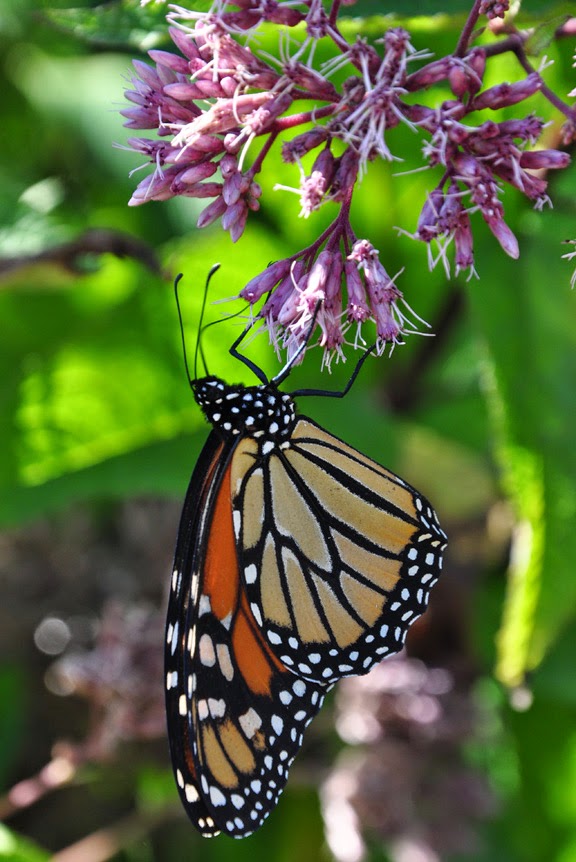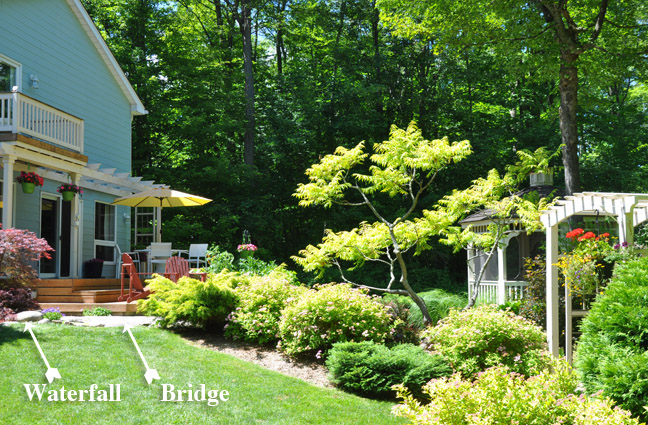Not far from the lakeshore in Mississauga, there is a old neighbourhood where the streets are lined with majestic trees. Though Lorne Park is not far from the busy city centre, it still manages to feel quiet, remote and lushly green.
Properties in this area have become so valuable that many of the neighbourhood's original homes have been torn down and replaced by million dollar mansions. You can spot the new builds in an instant. Their grand scale dominates the private lots. They lack both charm and character.
Thankfully, a few of the neighbourhood's older homes remain.
Sweet Rocket
Keith and Mary Ellen's Lorne Park home was built in 1914 by John Birch Canavan, a wealthy fur and woollen trader. At the time that the house was constructed, the area was still largely farmland, but it had already begun to be popular as a summer retreat for wealthy Torontonians, the Muskoka of its times.
"Like most of the other summer homes in the area, Canavan’s house was built in the bungalow style" says Keith,"It has a steeply pitched roof and a wrap around glass-paned porch on two sides. Originally the house would have been situated on a large lot (now much diminished) with an abundance of trees that would have complemented its cottage demeanour."
"Despite the fact that the house has only changed hands a few times over the past hundred years, it still retains many of its original Edwardian features. In 2002, the City of Mississauga gave the house heritage designation to recognize its unique architectural character."
While the different home owners managed to maintain the character of the house over the years, it seems that their interests didn’t extend to the surrounding land.
"When we bought the house in 1992," says Keith,"the gardens consisted of scruffy lawns, untended areas of ground cover (mostly Lily of the Valley) and an overgrown cedar hedge that had seen better days. The house called out for the grace and charm of a traditional, informal cottage garden."
One area that need to be addressed was the damp area near the road.
"The road in front of our house still has the feel of a country lane," says Mary Ellen,"Without a sidewalk, the only thing separating the garden from the road is a shallow drainage ditch. When we bought the house, the area was shabby and neglected. The ditch was full of weeds, the old cedar hedge along the front of the property was leggy and spare, and the lawn was thin and sparse. The only redeeming feature was the line of black locust trees along the ditch and a large stately black walnut tree, a little bit closer to the house."
Spring flowers in the "ditch" garden include Bleeding Heart, spring bulbs and Sweet Rocket (seen in the centre).
Once the area was cleaned up, Mary Ellen was able to begin to plant.
"After we took out the hedge, we needed to give the front some definition so we settled on day lilies, which provide much needed colour and grow well in the wild in similar conditions. In fact, our first plants were given to us by some of our relatives who live in the country in south-western Ontario."
"While the shade from the trees doesn’t seem to bother the day lilies, it certainly had an adverse affect on the lawn, so over time I dug out around the trees and started introducing hostas, flowering shrubs, Shasta Daisies and red Monarda. Fortunately, even though the ground is sandy, the trees provide some much needed natural compost so the soil never needs amending. The plants have all self-sowed quite happily, so much so in fact, I have taken out some of the day lilies and replaced them with peonies, irises, tulips, sedum and a few judiciously placed flowering shrubs."
"The garden can get quite moist, but there is still lots of sun and the soil drains well. Over time the beds have gradually expanded displacing more and more of the lawn which gives it the look that I was after. It does make keeping things under control quite a chore, so now that I am getting older, it’s time to downsize the flowers and put in more shrubs."
The planting along the front walkway and along the front porch makes extensive use of hosta.
Hostas are the backbone of any garden and they seem to do particularly well in our area," says Mary Ellen, "I now have about two hundred mature hostas– almost all of which came from the few hostas that were here when we bought the house. We bought a few specimens over the years, but the vast majority have come from dividing the plants as they mature. "
"Because the house is raised, the lawn originally came up a small embankment about two metres high to meet the ground floor, which made it very difficult to mow and didn’t look particularly attractive so I decided to put in terraces instead using stone found in the garden to build a dry stack retaining wall."
![]() Yellow Fumitory, Corydalis lutea has wonderful bright green, ferny foliage. The plant's tiny flowers appear in late spring and blooms for months without any deadheading. Yellow Fumitory likes well-drained soil and cool, part-shade. This perennial is a ready self-seeder, but unwanted seedlings are easy to remove. Height: 20-40 cm (8-16 inches), Spread: 25-30 cm (10-12 inches). USDA zones: 3-9.
Yellow Fumitory, Corydalis lutea has wonderful bright green, ferny foliage. The plant's tiny flowers appear in late spring and blooms for months without any deadheading. Yellow Fumitory likes well-drained soil and cool, part-shade. This perennial is a ready self-seeder, but unwanted seedlings are easy to remove. Height: 20-40 cm (8-16 inches), Spread: 25-30 cm (10-12 inches). USDA zones: 3-9.
"Someone gave me a piece of yellow corydalis and since it likes to fill in cracks and crevices. It was a natural choice to soften the hard edges of the wall and provide some colour. The fact that it contrasts so nicely with the green of the hostas was just a happy coincidence," says Mary Ellen.
I know many readers will look at these pristine hosta leaves and wonder what Mary Ellen does to control slug damage.
"I don’t do anything to control the slugs. I just let nature take its course. They are not much of a problem and, for the most part, don’t do very much damage. We have a lot more difficulty with cutworms and grubs," she says.
Next we'll head into the backyard where there is a picturesque courtyard and pond.
"The shed at the back of the garden was probably built about the same time as the house. It certainly looks like its been around for a hundred years, but it was never really integrated with the rest of the garden,"says Mary Ellen.
"I remember reading in a book written many years ago by Beverley Nichols, the English gardener and writer, that a garden tells you where things should go. The trees and bushes point to where the flowers should be. It’s the same with the paths. If you follow the natural flow that leads you from one garden area to the next, that’s where the walk goes."
"All the paths are built with old bricks and flagstone that I recovered from various parts of the garden. A few years ago, I came out to find that one of my shrubs had sunk about two feet almost overnight. It turned out that, unbeknownst to me, I had planted it where the old well used to be and the soil that had been used as backfill had settled. That was a great source of bricks. The rest came from the retaining wall that was taken out when we rebuilt the old concrete patio at the back of the house."
"I have added more paths and small patios over the years. They provide a much needed balance to the softer elements in the garden and, as an added bonus, they cut down on the amount of lawn I have to mow."
Some hamburgers, sausages and a few cases of beer lead to the creation of a pond in the back garden. Keith tells the full story:
"About ten years ago, a landscaping company asked us if we would be willing to host their “Build a Pond Day”, an annual event that they held to teach local contractors how to build a garden pond. We had a small pond that we had built in the back yard where the old well had been, but it didn’t really work, so we said “Why not?”
"A few weeks later, about twenty contractors arrived bright and early with wheelbarrows and shovels in hand. By the end of the day, they had excavated the pond, wrestled several large boulders into place, installed the recirculating lines and built a small waterfall at one end. Considering that it would have taken a landscaper a week or two to complete the job (it’s a substantial pond about eight metres long and two metres wide) it was no small feat. And the cost? A couple of cases of beer and enough barbecued hamburgers and sausages to keep the workers happy."
The only thing that remained to be done was the planting.
"The landscaping company’s generosity however didn’t extend past the pond. They left it up to us to put in the plants and integrate the pond into the rest of the garden, which gave us a whole new area of garden design to explore," says Keith.
1. Bleeding Heart 2. Climbing Rose (white) 3. Peony 4. Bleeding Heart 5. Deutzia 6. Hosta 7. Rudbeckia 8. Bearded Iris 9. Spirea Goldmound 10. Spirea Goldflame
Mary Ellen's List of Plants for Spring Color:
Bleeding Heart, Spring Bulbs, Creeping Phlox, Lamium (groundcover)
Plants for Early Summer Color:
Peony, Climbing Rose, Bearded Iris, Hosta, Spirea, Miss Kim Lilac, Beauty Bush, Japanese Iris
Plants for Late Summer Color:
Phlox, Pink Diamond Hydrangea, Forever Hydrangea, Brown-eyed Susan or Rudbeckia, Annual Flowers
Star of Bethlehem, Ornithogalum umbellatum is a member of the lily family and is a bulb that blooms in late spring. Star of Bethlehem is pretty, but be warned–it can be very aggressive. It should only be planted in an area where its invasive tendencies can be carefully contained.
Deutzia x lemoinei 'Compacta' (on the left above) has an upright habit and white flowers in spring. Plant it in sun to part-shade in average garden soil that is on the moist side. Prune in spring after flowering. Height: 4-6', Spread: the same. USDA Zones: 4-8.
Bleeding Heart, Dicentra spectabilis, 'Alba' (on the right and in closeup above) has bright green foliage and white flowers. Height: 70-90 cm (27-35 inches), Spread: 70-90 cm (27-35 inches). Light shade to full shade. Average to moist soil. Hardy: Zones 2-9.
"The round metal sphere decorated with entwined vines and leaves provides a lovely counterpoint to the shrubs and flowers in the rest of the garden, but while it looks like a piece of garden sculpture, it actually started out life as a shade for a chandelier that we bought on a whim at a garage sale. When we looked around the house we realized that it really didn’t work as a light fixture, so we threw away the electrics and stuck the shade on a metal tripod. It’s been a feature of the garden ever since,"says Mary Ellen.
I think you'll agree that the work Mary Ellen and Keith have done on the landscaping really enhances the style and character of their century home. It may not be the grandest house in the neighbourhood, but it is certainly one of the nicest.








































































































































































































































































